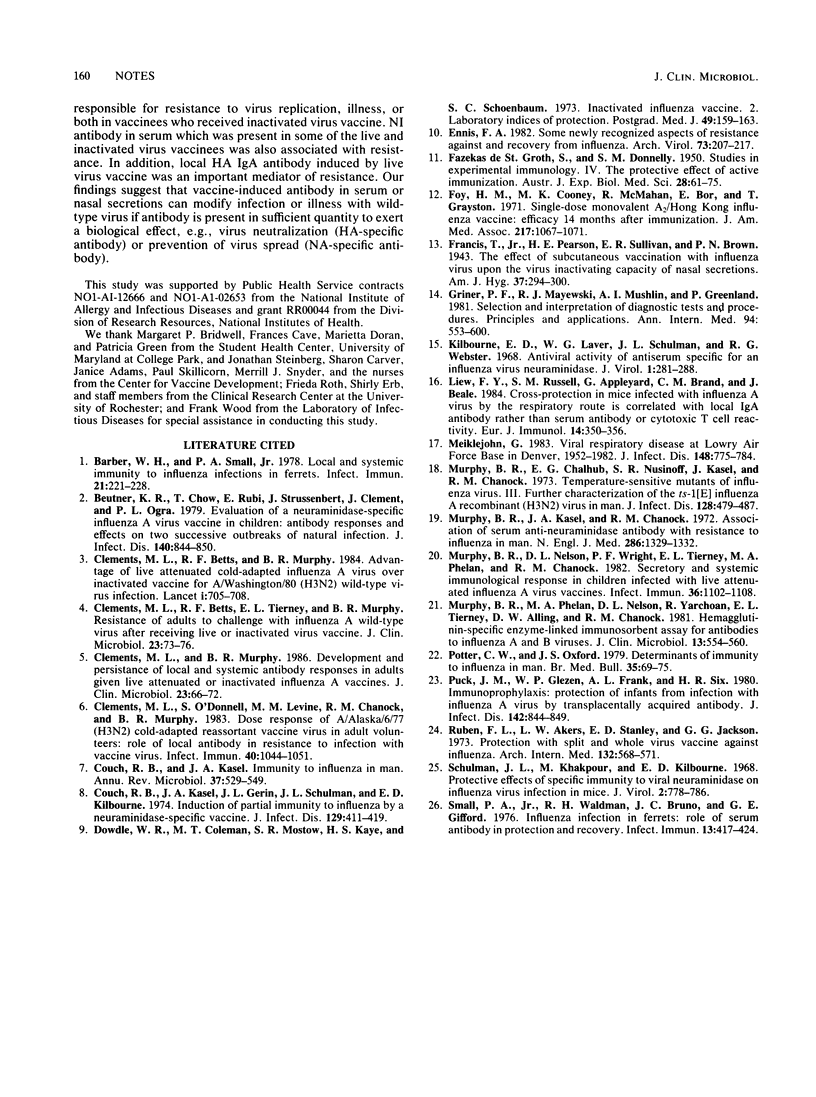Abstract
To identify immunological predictors of resistance to influenza A infection and illness, the immunological status of live and inactivated virus vaccines subsequently challenged with H1N1 or H3N2 wild-type virus was examined. We refer to prechallenge antibodies of vaccinees receiving live attenuated virus as infection induced and those receiving inactivated virus as inactivated vaccine induced. Inactivated vaccine-induced protection against wild-type virus infection or illness correlated with the level of neuraminidase-inhibiting antibody in serum, local hemagglutinin immunoglobulin G (IgG) (but not IgA) enzyme-linked immunosorbent assay antibody, and hemagglutination-inhibiting antibody in serum. In contrast, infection-induced resistance to wild-type virus infection correlated with local hemagglutinin IgA antibody and neuraminidase-inhibiting antibody in serum, but not with hemagglutination-inhibiting antibody in serum. These observations suggest that live vaccine virus infection-induced and inactivated vaccine-induced immunity may involve different compartments of the immune system; sufficient antibody in either serum or nasal secretions is capable of conferring resistance.
Full text
PDF



Selected References
These references are in PubMed. This may not be the complete list of references from this article.
- Barber W. H., Small P. A., Jr Local and systemic immunity to influenza infections in ferrets. Infect Immun. 1978 Jul;21(1):221–228. doi: 10.1128/iai.21.1.221-228.1978. [DOI] [PMC free article] [PubMed] [Google Scholar]
- Beutner K. R., Chow T., Rubi E., Strussenberg J., Clement J., Ogra P. L. Evaluation of a neuraminidase-specific influenza A virus vaccine in children: antibody responses and effects on two successive outbreaks of natural infection. J Infect Dis. 1979 Dec;140(6):844–850. doi: 10.1093/infdis/140.6.844. [DOI] [PubMed] [Google Scholar]
- Clements M. L., Betts R. F., Murphy B. R. Advantage of live attenuated cold-adapted influenza A virus over inactivated vaccine for A/Washington/80 (H3N2) wild-type virus infection. Lancet. 1984 Mar 31;1(8379):705–708. doi: 10.1016/s0140-6736(84)92222-0. [DOI] [PubMed] [Google Scholar]
- Clements M. L., Murphy B. R. Development and persistence of local and systemic antibody responses in adults given live attenuated or inactivated influenza A virus vaccine. J Clin Microbiol. 1986 Jan;23(1):66–72. doi: 10.1128/jcm.23.1.66-72.1986. [DOI] [PMC free article] [PubMed] [Google Scholar]
- Clements M. L., O'Donnell S., Levine M. M., Chanock R. M., Murphy B. R. Dose response of A/Alaska/6/77 (H3N2) cold-adapted reassortant vaccine virus in adult volunteers: role of local antibody in resistance to infection with vaccine virus. Infect Immun. 1983 Jun;40(3):1044–1051. doi: 10.1128/iai.40.3.1044-1051.1983. [DOI] [PMC free article] [PubMed] [Google Scholar]
- Couch R. B., Kasel J. A., Gerin J. L., Schulman J. L., Kilbourne E. D. Induction of partial immunity to influenza by a neuraminidase-specific vaccine. J Infect Dis. 1974 Apr;129(4):411–420. doi: 10.1093/infdis/129.4.411. [DOI] [PubMed] [Google Scholar]
- Dowdle W. R., Coleman M. T., Mostow S. R., Kaye H. S., Schoenbaum S. C. Inactivated influenza vaccines. 2. Laboratory indices of protection. Postgrad Med J. 1973 Mar;49(569):159–163. doi: 10.1136/pgmj.49.569.159. [DOI] [PMC free article] [PubMed] [Google Scholar]
- Ennis A. Some newly recognized aspects of resistance against and recovery from influenza. Arch Virol. 1982;73(3-4):207–217. doi: 10.1007/BF01318075. [DOI] [PubMed] [Google Scholar]
- FAZEKAS de ST GROTH S., DONNELLEY M. Studies in experimental immunology of influenza. IV. The protective value of active immunization. Aust J Exp Biol Med Sci. 1950 Jan;28(1):61–75. doi: 10.1038/icb.1950.5. [DOI] [PubMed] [Google Scholar]
- Foy H. M., Cooney M. K., McMahan R., Bor E., Grayston J. T. Single-dose monovalent A 2 -Hong Kong influenza vaccine. Efficacy 14 months after immunization. JAMA. 1971 Aug 23;217(8):1067–1071. [PubMed] [Google Scholar]
- Kilbourne E. D., Laver W. G., Schulman J. L., Webster R. G. Antiviral activity of antiserum specific for an influenza virus neuraminidase. J Virol. 1968 Apr;2(4):281–288. doi: 10.1128/jvi.2.4.281-288.1968. [DOI] [PMC free article] [PubMed] [Google Scholar]
- Liew F. Y., Russell S. M., Appleyard G., Brand C. M., Beale J. Cross-protection in mice infected with influenza A virus by the respiratory route is correlated with local IgA antibody rather than serum antibody or cytotoxic T cell reactivity. Eur J Immunol. 1984 Apr;14(4):350–356. doi: 10.1002/eji.1830140414. [DOI] [PubMed] [Google Scholar]
- Meiklejohn G. Viral respiratory disease at Lowry Air Force Base in Denver, 1952-1982. J Infect Dis. 1983 Nov;148(5):775–784. doi: 10.1093/infdis/148.5.775. [DOI] [PubMed] [Google Scholar]
- Murphy B. R., Chalhub E. G., Nusinoff S. R., Kasel J., Chanock R. M. Temperature-sensitive mutants of influenza virus. 3. Further characterization of the ts-1(E) influenza A recombinant (H3N2) virus in man. J Infect Dis. 1973 Oct;128(4):479–487. doi: 10.1093/infdis/128.4.479. [DOI] [PubMed] [Google Scholar]
- Murphy B. R., Kasel J. A., Chanock R. M. Association of serum anti-neuraminidase antibody with resistance to influenza in man. N Engl J Med. 1972 Jun 22;286(25):1329–1332. doi: 10.1056/NEJM197206222862502. [DOI] [PubMed] [Google Scholar]
- Murphy B. R., Nelson D. L., Wright P. F., Tierney E. L., Phelan M. A., Chanock R. M. Secretory and systemic immunological response in children infected with live attenuated influenza A virus vaccines. Infect Immun. 1982 Jun;36(3):1102–1108. doi: 10.1128/iai.36.3.1102-1108.1982. [DOI] [PMC free article] [PubMed] [Google Scholar]
- Murphy B. R., Phelan M. A., Nelson D. L., Yarchoan R., Tierney E. L., Alling D. W., Chanock R. M. Hemagglutinin-specific enzyme-linked immunosorbent assay for antibodies to influenza A and B viruses. J Clin Microbiol. 1981 Mar;13(3):554–560. doi: 10.1128/jcm.13.3.554-560.1981. [DOI] [PMC free article] [PubMed] [Google Scholar]
- Potter C. W., Oxford J. S. Determinants of immunity to influenza infection in man. Br Med Bull. 1979 Jan;35(1):69–75. doi: 10.1093/oxfordjournals.bmb.a071545. [DOI] [PubMed] [Google Scholar]
- Puck J. M., Glezen W. P., Frank A. L., Six H. R. Protection of infants from infection with influenza A virus by transplacentally acquired antibody. J Infect Dis. 1980 Dec;142(6):844–849. doi: 10.1093/infdis/142.6.844. [DOI] [PubMed] [Google Scholar]
- Ruben F. L., Akers L. W., Stanley E. D., Jackson G. G. Protection with split and whole virus vaccines against influenza. Arch Intern Med. 1973 Oct;132(4):568–571. [PubMed] [Google Scholar]
- Schulman J. L., Khakpour M., Kilbourne E. D. Protective effects of specific immunity to viral neuraminidase on influenza virus infection of mice. J Virol. 1968 Aug;2(8):778–786. doi: 10.1128/jvi.2.8.778-786.1968. [DOI] [PMC free article] [PubMed] [Google Scholar]
- Small P. A., Jr, Waldman R. H., Bruno J. C., Gifford G. E. Influenza infection in ferrets: role of serum antibody in protection and recovery. Infect Immun. 1976 Feb;13(2):417–424. doi: 10.1128/iai.13.2.417-424.1976. [DOI] [PMC free article] [PubMed] [Google Scholar]


